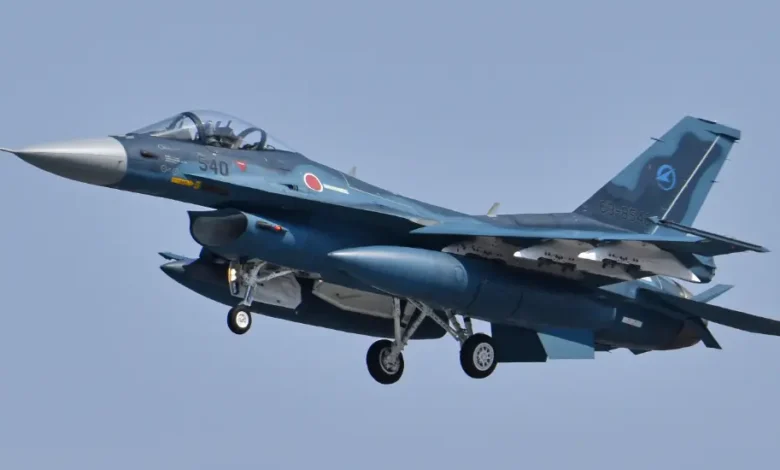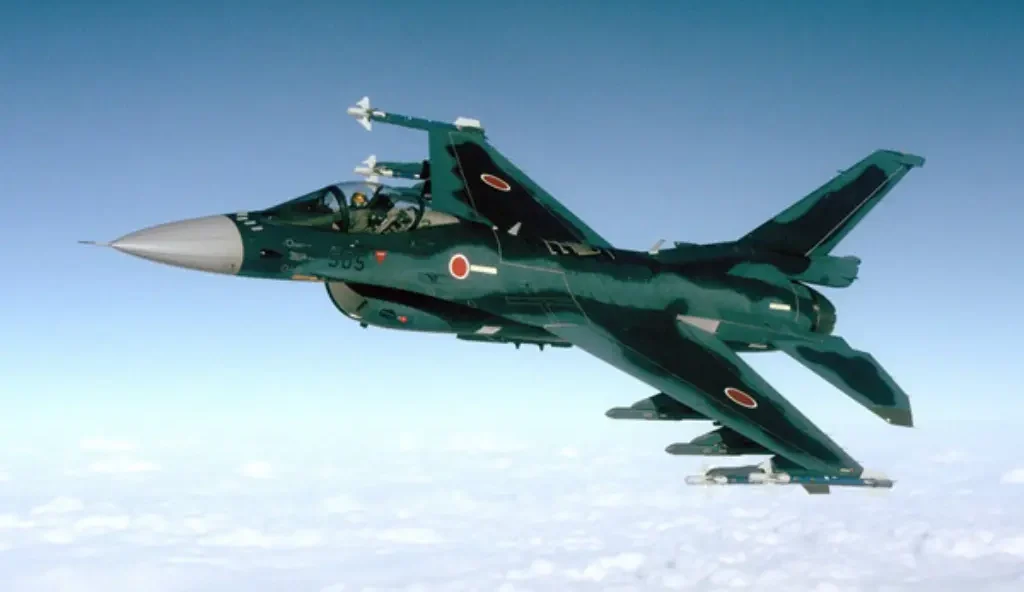Mitsubishi F-2

The Mitsubishi F-2 is a multirole fighter aircraft developed jointly by Mitsubishi Heavy Industries and Lockheed Martin for the Japan Air Self-Defense Force (JASDF). Based on the F-16 Fighting Falcon, the F-2 features a larger airframe, advanced avionics, and enhanced capabilities tailored to Japan’s defense needs. First flown in 1995 and introduced in 2000, the F-2 is designed for air superiority, ground attack, and maritime strike missions.
Fact Sheet
| Role | Multirole fighter |
|---|---|
| Manufacturer | Mitsubishi Heavy Industries / Lockheed Martin |
| First Flight | 1995 |
| Service Entry | 2000 |
| Crew | 1 (F-2A) or 2 (F-2B) |
Specifications
| Length | 15.52 m (50 ft 11 in) |
|---|---|
| Wingspan | 11.13 m (36 ft 6 in) |
| Height | 4.96 m (16 ft 3 in) |
| Empty Weight | 9,527 kg (21,000 lb) |
| Max Takeoff Weight | 22,100 kg (48,720 lb) |
| Powerplant | 1 × General Electric F110-GE-129 turbofan |
| Thrust | 29,000 lbf (129 kN) with afterburner |
| Max Speed | Mach 2.0 (2,470 km/h; 1,535 mph) |
| Service Ceiling | 15,240 m (50,000 ft) |
| Range | 520 mi (840 km) combat radius |
| Rate of Climb | ~50,000 ft/min (254 m/s) |
Avionics & Armament
| Main Radar | J/APG-2 AESA radar |
|---|---|
| Avionics | Advanced avionics suite, electronic warfare systems |
| Armament | One 20-mm JM61A1 rotary cannon; Up to 13 external hardpoints for: – Air-to-air missiles (AIM-7, AIM-9, AAM-4) – Air-to-ground munitions (bombs, rockets) – Anti-ship missiles (ASM-1, ASM-2) – External fuel tanks |
Notable Features
- Joint development between Japan and the United States.
- Enhanced airframe with larger wings for improved performance.
- Advanced avionics for superior situational awareness.
- Multirole capability for air-to-air, air-to-ground, and maritime strike missions.
- Continuously upgraded to meet modern combat requirements.

Mitsubishi F-2: Japan’s Homegrown Multi-Role Fighter
The Mitsubishi F-2 is a single-engine, multi-role fighter aircraft developed jointly by Mitsubishi Heavy Industries (MHI) of Japan and Lockheed Martin of the United States. While derived from the General Dynamics (now Lockheed Martin) F-16 Fighting Falcon, the F-2 incorporates significant Japanese design modifications and technologies, making it a unique and highly capable aircraft primarily tailored for the Japan Air Self-Defense Force (JASDF).
F-2 Development & US-Japan Cooperation
The F-2 program, initially known as the FS-X, began in the mid-1980s as Japan sought a successor to its aging Mitsubishi F-1 fighter. Japan initially aimed for an entirely indigenous design, but due to U.S. pressure and concerns over technology transfer, the project evolved into a joint development program based on the F-16C Block 40. This collaboration involved a 60/40 workshare split, with Japan (MHI) responsible for 60% of the production and the U.S. (Lockheed Martin) for 40%. The first prototype flew in October 1995, and the F-2 officially entered JASDF service in 2000. A total of 98 aircraft (including 4 prototypes) were produced between 1996 and 2011.
F-2 Design Features: Enhanced F-16 & Composites
The F-2’s design distinguishes it significantly from its F-16 progenitor, emphasizing maritime strike capabilities and the use of advanced materials.
- Enlarged Wing Area: The F-2 features a 25% larger wing area compared to the F-16, which allows for increased internal fuel storage (4,637 litres) and more external hardpoints. This larger wing, along with enlarged horizontal tails, contributes to enhanced maneuverability and payload capacity.
- Advanced Composite Construction: The wings are notably fabricated using co-cured graphite-epoxy composite materials, a pioneering application in a production tactical fighter to maximize strength while minimizing weight. Radar-absorbing material (RAM) is also applied to certain areas like the nose, wing leading edges, and engine inlet for reduced radar signature.
- Single Engine Powerplant: Powered by a single General Electric F110-IHI-129 afterburning turbofan engine, license-produced by IHI. This engine delivers approximately 131.7 kN (29,500 lbf) of thrust with afterburner, enabling a maximum speed of Mach 2.0 at high altitude.
- Digital Fly-by-Wire (FBW): It features a Japanese-designed, triple-redundant digital fly-by-wire flight control system for high maneuverability and excellent flight characteristics.
- Three-Piece Canopy: A distinguishing visual feature compared to the F-16 is its three-piece cockpit canopy (vs. F-16’s two-piece).
F-2 Avionics & Armament: Pioneer AESA Radar & Anti-Ship Focus
The F-2 is equipped with advanced Japanese-developed avionics and a diverse armament suite optimized for both air-to-air and anti-ship missions.
- J/APG-1/2 AESA Radar: The F-2 was the first production fighter aircraft in the world to be equipped with an Active Electronically Scanned Array (AESA) radar, the Mitsubishi Electric J/APG-1. Later upgrades introduced the more powerful J/APG-2 Gallium Nitride (GaN) AESA radar, enhancing its detection range and multi-target engagement capabilities.
- Integrated EW System: It features a Mitsubishi Electric integrated electronic warfare system for self-protection.
- Glass Cockpit: The cockpit includes three multi-function displays (MFDs) and a holographic wide-angle Head-Up Display (HUD).
- Weapon Hardpoints: The F-2 has 13 external hardpoints (one centerline, two wingtip, and five under each wing), allowing for a substantial external stores load of up to 8,085 kg (17,824 lb).
- Internal Cannon: Equipped with a 20 mm JM61A1 Vulcan cannon in the port wing root.
- Air-to-Air Missiles (AAMs): Capable of carrying AIM-9 Sidewinder (short-range), AIM-7 Sparrow (medium-range), and indigenously developed missiles such as the AAM-3 (short-range), AAM-4 (medium-range, active radar homing, with AAM-4B having AESA seeker), and AAM-5 (short-range, high off-boresight).
- Anti-Ship Missiles (ASMs): A key capability of the F-2 is its ability to carry up to four ASM-1 and ASM-2 anti-ship missiles (Type 80 and Type 93 respectively). It is also being integrated with the supersonic ASM-3 anti-ship missile, significantly enhancing its naval strike capabilities.
- Air-to-Ground Munitions: Can deploy various unguided bombs (Mk 82, Mk 83), JDAM (Joint Direct Attack Munition) guided bombs, and cluster bombs (CBU-87/B). It is also compatible with the Lockheed Martin Sniper® Advanced Targeting Pod.
F-2 Variants & Upgrades
The F-2 family consists of two primary variants, both undergoing continuous modernization:
- F-2A: The single-seat multi-role fighter variant.
- F-2B: The two-seat tandem trainer variant. The F-2B has a slightly increased empty weight and reduced internal fuel load compared to the F-2A.
- Mid-Life Upgrades (MLU): The F-2 fleet has undergone significant MLU programs, including the introduction of the J/APG-2 AESA radar, integration of advanced indigenous missiles like the AAM-4B and ASM-3, and enhanced targeting capabilities with pods like Sniper.
F-2 Operational History & Current Status
- Japan (Japan Air Self-Defense Force – JASDF): The sole operator.
- The F-2 is primarily tasked with maritime strike (protecting Japan’s sea lanes) and air defense roles.
- In March 2011, some F-2B aircraft were damaged by the tsunami following the Tōhoku earthquake, with some later being repaired and returned to service.
- The F-2 is actively used in air policing missions, intercepting foreign aircraft approaching Japanese airspace.
- As of mid-2025, the F-2 remains a vital component of the JASDF, operating alongside the F-15J/DJ and F-35A. There are ongoing discussions about its eventual replacement by Japan’s next-generation fighter program, the GX/F-3 program.
- The Philippines recently expressed interest in acquiring second-hand F-2s from Japan, though this faces significant hurdles due to Japanese arms export regulations and the F-2 production line being closed since 2011.
The Mitsubishi F-2 stands as a testament to Japan’s advanced aerospace industry and its strategic partnership with the United States. It is a highly capable multi-role fighter, particularly adept at anti-ship operations, and remains a crucial asset for Japan’s national defense.



